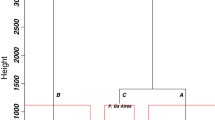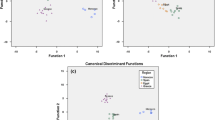Abstract
This study was performed with floral honeys from an innovator and pioneer project in Brazil for the digital monitoring of beehives. Samples from six regions of the Santa Catarina state were evaluated for moisture, acidity, pH, electrical conductivity, 5-HMF, diastase activity, fructose, glucose, sucrose, and minerals (K, Ca, Na, Mg, and Mn). Furthermore, chemometric analyzes were applied to classify honeys based on these parameters. Some results did not corroborate with the current legislation for free acidity (≤ 50 mEq kg−1) and electrical conductivity (≤ 0.8 mS cm−1). In all samples, the minerals K (0.37 × 103 to 3.03 × 103 mg kg−1) and Ca (0.03 × 103 to 0.38 × 103 mg kg−1) were majority. Considering that the results were different (p < 0.05) for all floral honey samples, cluster and principal components analysis (PCA) were performed to group samples by similarity. Cluster analysis provided a first separation of the honeys and PCA highlighted the K, Ca, Mg, and Na as the best contributors for honeys discrimination. In this regard, the physicochemical parameters, sugar, and mineral content were important to elucidate the characteristics of honeys. They indicated that the beehives handling and the hygienic-sanitary conditions during the collection and transport of samples were also adequate. Furthermore, mineral elements were proposed to discriminate honey samples produced in different regions of Santa Catarina state, Brazil.




Similar content being viewed by others
Availability of data and material
The authors declare that all data are presented in the manuscript in Figures and Tables. The background data, if required, will be made available on request.
Code availability
Not Applicable.
References
Brasil. Ministério da Agricultura Pecuária e Abastecimento. Instrução Normativa nº 11, de 20 de outubro de 2000. Regulamento técnico de identidade e qualidade do mel. Diário Oficial, Brasília, 20 de outubro de 2000. Available from: http://extranet.agricultura.gov.br/sislegisconsulta/consultarLegislacao.do?operacao=visualizar&id=7797. Accessed 10 June 2021
European Comission (2002) European Commission Council Directive 2001/110/EC of 20 December 2001 relating to honey. Off J Eur Commun 10:47
Codex Alimentarius (2001) Revised Codex Standard for Honey, Standards and Standard Methods. In: Codex Alimentarius Commission FAO/OMS. Available from http://www.fao.org/fao-who-codexalimentarius/sh-proxy/en/?lnk=1&url=https%253A%252F%252Fworkspace.fao.org%252Fsites%252Fcodex%252FStandards%252FCXS%2B12-1981%252FCXS_012e.pdf Accessed 5 June 2021
Silva PM, Gauche C, Gonzaga LV, Costa ACO, Fett R (2016) Honey: chemical composition, stability and authenticity. Food Chem 196:309–323. https://doi.org/10.1016/j.foodchem.2015.09.051
De-Melo AAM, de Almeida-Muradian LB, Sancho MT, Pascual-Maté A (2017) Composition and properties of Apis mellifera honey: a review. J Apic Res 57(1):5–37. https://doi.org/10.1080/00218839.2017.1338444
Seraglio SKT, da Silva B, Bergamo G, Brugnerotto P, Gonzaga LV, Fett R, et al. (2019) An overview of physicochemical characteristics and health-promoting properties of honeydew honey. Food Res Int. 119:44–66. https://doi.org/10.1016/j.foodres.2019.01.028
IBGE (2018) Tabela 74 - Produção de origem animal por tipo de produto - Ano 2018. Instituto Brasileiro de Geografia e Estatísitica. Available from: https://sidra.ibge.gov.br/tabela/74#resultado. Accessed 1 Feb 2021
Epagri (2018) Tecnologia para o desenvolvimento da Apicultura Catarinense. Empresa de Pesquisa Agropecuária e Extensão Rural de Santa Catarina. p. 1–2. Available from: https://ciram.epagri.sc.gov.br/ciram_arquivos/apicultura/acervo/folder_apis_on_line.pdf. Accessed 10 Feb 2021
Thomé VMR, Zampieri S, Braga HJ, Pandolfo C, da Silva Júnior VP, Laus Neto J, Soldateli D, Gebler E, Ore JD, Echeverria L et al (1999) Zoneamento Agroecológico e Socioeconômico de Santa Catarina. Epagri, Florianópolis, p 1000
AOAC (2005). Official methods of analysis of AOAC International, 18th edn. AOAC International, Gaithersburg. Available from https://www.aoac.org/official-methods-of-analysis-21st-edition-2019/#:~:text=Official%20Methods%20of%20Analysis%20(OMA,of%20more%203%2C000%20validated%20methods.&text=Official%20Methods%20of%20Analysis%20(OMA)%20is%20the%20most%20comprehensive%20and,methods%20and%20consensus%20standards%20available. Accessed 5 June 2021
Bogdanov S, Lüllmann C, Martin P, Von Der Ohe W, Russmann H, Vorwohl G et al (1999) Honey quality and international regulatory standards: review by the International Honey Commission. Bee World 80(2):61–69. https://doi.org/10.1080/0005772X.1999.11099428
Rizelio VM, Tenfen L, da Silveira R, Gonzaga LV, Costa ACO, Fett R (2012) Development of a fast capillary electrophoresis method for determination of carbohydrates in honey samples. Talanta. 93:62–6. https://doi.org/10.1016/j.talanta.2012.01.034
Rizelio VM, Gonzaga LV, Borges GDSC, França Maltez H, Costa ACO, Fett R (2012) Fast determination of cations in honey by capillary electrophoresis: A possible method for geographic origin discrimination. Talanta. 99:450–6. https://doi.org/10.1016/j.talanta.2012.06.009
Nguyen HTL, Panyoyai N, Paramita VD, Mantri N, Kasapis S (2018) Physicochemical and viscoelastic properties of honey from medicinal plants. Food Chem 241(March 2017):143–149. https://doi.org/10.1016/j.foodchem.2017.08.070
Sakač MB, Jovanov PT, Marić AZ, Pezo LL, Kevrešan ŽS, Novaković AR et al (2019) Physicochemical properties and mineral content of honey samples from Vojvodina (Republic of Serbia). Food Chem 27: 15–21. https://doi.org/10.1016/j.foodchem.2018.09.149
Oroian M, Ropciuc S (2017) Honey authentication based on physicochemical parameters and phenolic compounds. Comput Electron Agric 138:148–156. https://doi.org/10.1016/j.compag.2017.04.020
Nayik GA, Dar BN, Nanda V (2015) Physico-chemical, rheological and sugar profile of different unifloral honeys from Kashmir valley of India. Arab J Chem. https://doi.org/10.1016/j.arabjc.2015.08.017
Karabagias IK, Louppis AP, Karabournioti S, Kontakos S, Papastephanou C, Kontominas MG (2017) Characterization and geographical discrimination of commercial Citrus spp. honeys produced in different Mediterranean countries based on minerals, volatile compounds and physicochemical parameters, using chemometrics. Food Chem 217:445–455. https://doi.org/10.1016/j.foodchem.2016.08.124
Pereira JR, da Campos RAN, de Oliveira FC, Silva VRO, David GF, Da Silva JG et al (2020) Physical-chemical characterization of commercial honeys from Minas Gerais, Brazil. Food Biosci 36:1–10. https://doi.org/10.1016/j.fbio.2020.100644
Mračević SĐ, Krstić M, Lolić A, Ražić S (2020) Comparative study of the chemical composition and biological potential of honey from different regions of Serbia. Microchem J 152:1–9. https://doi.org/10.1016/j.microc.2019.104420
Bergamo G, Seraglio SKT, Gonzaga LV, Fett R, Costa ACO (2019) Physicochemical characteristics of bracatinga honeydew honey and blossom honey produced in the state of Santa Catarina: An approach to honey differentiation. Food Res Int. 116:745–54. https://doi.org/10.1016/j.foodres.2018.09.007
Fechner DC, Hidalgo MJ, Ruiz Díaz JD, Gil RA, Pellerano RG (2020) Geographical origin authentication of honey produced in Argentina. Food Biosci 33(February 2019):100483. https://doi.org/10.1016/j.fbio.2019.100483
Brugnerotto P, Della Betta F, Gonzaga LV, Fett R, Oliveira Costa AC (2019) A capillary electrophoresis method to determine aliphatic organic acids in bracatinga honeydew honey and floral honey. J Food Compos Anal. https://doi.org/10.1016/j.jfca.2019.103243
Codex Alimentarius Commission (2001) Codex Alimentarius Commission Standards. Codex Stan 12-1981. 1–8
Geană EI, Ciucure CT, Costinel D, Ionete RE (2020) Evaluation of honey in terms of quality and authenticity based on the general physicochemical pattern, major sugar composition and δ13C signature. Food Control 109:106919. https://doi.org/10.1016/j.foodcont.2019.106919
Chakir A, Romane A, Ferrazzi P, Luigi G (2016) Physicochemical properties of some honeys produced from different plants in Morocco. Arab J Chem 9:946–954. https://doi.org/10.1016/j.arabjc.2011.10.013
Rodríguez I, Cámara-Martos F, Flores JM, Serrano S (2019) Spanish avocado (Persea americana Mill.)honey: authentication based on its composition criteria, mineral content and sensory attributes. Lwt 111(February):561–572. https://doi.org/10.1016/j.lwt.2019.05.068
Fechner DC, Moresi AL, Ruiz Díaz JD, Pellerano RG, Vazquez FA (2016) Multivariate classification of honeys from corrientes (Argentina) according to geographical origin based on physicochemical properties. Food Biosci 15:49–54. https://doi.org/10.1016/j.fbio.2016.05.002
Bergamo G, Tischer Seraglio SK, Gonzaga LV, Fett R, Costa ACO (2018) Mineral profile as a potential parameter for verifying the authenticity of bracatinga honeydew honeys. LWT 97:390–395. https://doi.org/10.1016/j.lwt.2018.07.028
Kaygusuz H, Tezcan F, Erim FB, Yildiz O, Sahin H, Can Z et al (2016) Characterization of Anatolian honeys based on minerals, bioactive components and principal component analysis. LWT Food Sci Technol 68:273–279. https://doi.org/10.1016/j.lwt.2015.12.005
Karabagias IK, Louppis AP, Kontakos S, Papastephanou C, Kontominas MG (2017) Characterization and geographical discrimination of Greek pine and thyme honeys based on their mineral content, using chemometrics. Eur Food Res Technol 243(1):101–113. https://doi.org/10.1007/s00217-016-2727-8
Rizelio VM, Gonzaga LV, Da Silva Campelo Borges G, Micke GA, Fett R, Costa ACO (2012) Development of a fast MECK method for determination of 5-HMF in honey samples (c). Food Chem 133(4):1640–1645. https://doi.org/10.1016/j.foodchem.2011.11.058
da Silva PM, Gonzaga LV, Biluca FC, Schulz M, Vitali L, Micke GA, et al. (2020) Stability of Brazilian Apis mellifera L. honey during prolonged storage: Physicochemical parameters and bioactive compounds. LWT. 129:109521. https://doi.org/10.1016/j.lwt.2020.109521
Rodríguez-Flores MS, Escuredo O, Míguez M, Seijo MC (2019) Differentiation of oak honeydew and chestnut honeys from the same geographical origin using chemometric methods. Food Chem 297:124979. https://doi.org/10.1016/j.foodchem.2019.124979
Bystrzanowska M, Tobiszewski M (2020) Chemometrics for selection, prediction, and classification of sustainable solutions for green chemistry—a review. Symmetry (Basel) 12(12):1–21. https://doi.org/10.3390/sym12122055
Karabagias IK, Vlasiou M, Kontakos S, Drouza C, Kontominas MG, Keramidas AD (2018) Geographical discrimination of pine and fir honeys using multivariate analyses of major and minor honey components identified by1H NMR and HPLC along with physicochemical data. Eur Food Res Technol 244(7):1249–1259. https://doi.org/10.1007/s00217-018-3040-5
Azevedo MS, Seraglio SKT, Rocha G, Balderas CB, Piovezan M, Gonzaga LV et al (2017) Free amino acid determination by GC-MS combined with a chemometric approach for geographical classification of bracatinga honeydew honey (Mimosa scabrella Bentham). Food Control 78:383–392. https://doi.org/10.1016/j.foodcont.2017.03.008
Funding
This study was supported by the Coordenação de Aperfeiçoamento de Pessoal de Nível Superior (CAPES) (Financial code—001), the Fundação de Amparo à Pesquisa e Inovação do estado de Santa Catarina (FAPESC) (No. 88887.178578/2018-00), and the Conselho Nacional de Desenvolvimento Científico e Tecnológico (CNPq) (No 150371/2019-5, No. 160175/2019-4, and No. 153639/2019-9).
Author information
Authors and Affiliations
Corresponding authors
Ethics declarations
Conflict of interest
The authors declare that they have no known competing financial interests or personal relationships that could have appeared to influence the study reported in this paper.
Research involving human participants and/or animals
This paper does not contain any studies with human or animal subjects.
Additional information
Publisher's Note
Springer Nature remains neutral with regard to jurisdictional claims in published maps and institutional affiliations.
Rights and permissions
About this article
Cite this article
Brugnerotto, P., Silva, B., Seraglio, S.K.T. et al. Physicochemical characterization of honeys from Brazilian monitored beehives. Eur Food Res Technol 247, 2709–2719 (2021). https://doi.org/10.1007/s00217-021-03805-y
Received:
Revised:
Accepted:
Published:
Issue Date:
DOI: https://doi.org/10.1007/s00217-021-03805-y




